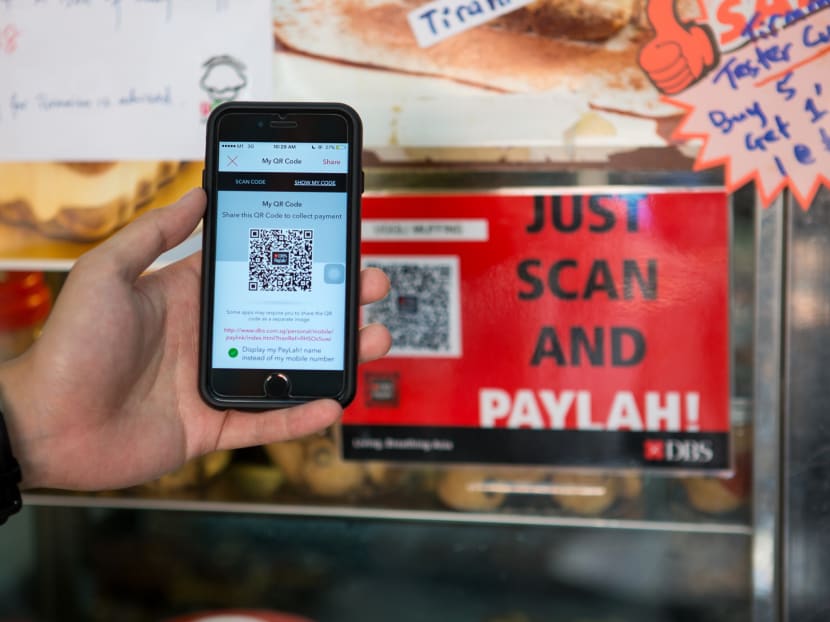‘Negligible’ space and cost for users could help national QR code take off
SINGAPORE — Payment scheme providers and merchants welcomed the upcoming national QR (quick response) code scheme, saying it would unify the “fragmented” mobile payments space and offer convenience to travellers who are used to paying using their phones.

Members of Parliament have filed questions on the Government's cashless drive, particularly on what kind of help will be available to the elderly as this group has relied on cash as their only mode of payment all along. Photo: DBS
SINGAPORE — Payment scheme providers and merchants welcomed the upcoming national QR (quick response) code scheme, saying it would unify the “fragmented” mobile payments space and offer convenience to travellers who are used to paying using their phones.
However, they said the common QR code must be “complementary” and used along with other payment platforms to cater to the varied needs of consumers and merchants across various industries.
Prime Minister Lee Hsien Loong had said during the National Day Rally that simplified and integrated platforms could help cashless transactions take off here.
The Monetary Authority of Singapore is working to integrate the different systems, such as by making the QR code payment method available for PayNow, a mobile service rolled out by the Association of Banks in Singapore in July. It allows users to transfer funds directly to one another using their mobile phone numbers.
Cash is still “heavily used” in hawker centres and for transport, and a switch to electronic payments will require a shift in mentality, said Ms Ooi Huey Tyng, Visa’s country manager for Singapore and Brunei. “There is also an emotional connection tied to using cash (felt) by merchants that are heavily cash-based,” she said.
Ms Rachel Hunt, marketing director for Asia-Pacific and Japan of banking and payment solutions provider ACI Worldwide, said standardisation measures – like QR codes and PayNow – must “be mindful of the need to stay inclusive”.
“Many consumers prefer the perceived reliability and physical presence of cash...There has also been a lot of fragmentation in the payments ecosystem, with a multitude of cards and mobile payment options on top of cash,” she said.
A Mastercard spokesperson said QR codes are targeted at locations that currently do not accept e-payments, as some merchants do not find it economically viable to have traditional point-of-sales devices. On whether Mastercard PayPass may be crowded out of the market, the spokesperson said QR-based payments deliver additional choice. She noted: “The introduction of contactless did not slow down the growth of EMV or chip cards. When consumers want to pay with their mobile, we are now offering the choice of scan, in additional to tap. We expect this will help grow the use of mobile wallets.”
Industry players said “inter-operability” is a key ingredient for e-payments to take flight. This means having a common platform that all merchants and consumers can use, regardless of which payment scheme they sign up for.
Having a national QR code will also enable businesses to better serve the needs of tourists and business travellers who are “used to paying using such a solution”, said Visa’s Ms Ooi.
Hawker Melvin Chew, 39, is offering Liquid Pay and Alipay at his Jin Ji Teochew Braised Duck outlet at Chinatown Complex, partly because it helps him to “reach a wider group of customers”, including Chinese tourists.
Uggli Muffins owner Tan Chee Pin, who operates at a food centre in Toa Payoh, said a national QR code could prove popular with small business owners like hawkers, because the space and cost involved is likely to be negligible.
“There is less incentive to install point-of-sale terminals because you need, at least, a laptop or a tablet, and space to set up the terminals,” said the 47-year-old, whose outlet currently offers QR code payments to DBS PayLah! users.
Consumers also need not carry multiple credit cards, he added.
Overseas, a standardised QR code — dubbed Bharat QR — was launched in India earlier this year, which accepts payments via MasterCard, Visa, American Express and domestic scheme RuPay. Consumers scan the code using their bank’s app and enter the amount to be paid. The transaction must then be authenticated using four-digit codes sent to their phones.
According to Bangkok Post, a similar scheme is expected to be launched in Thailand soon.






